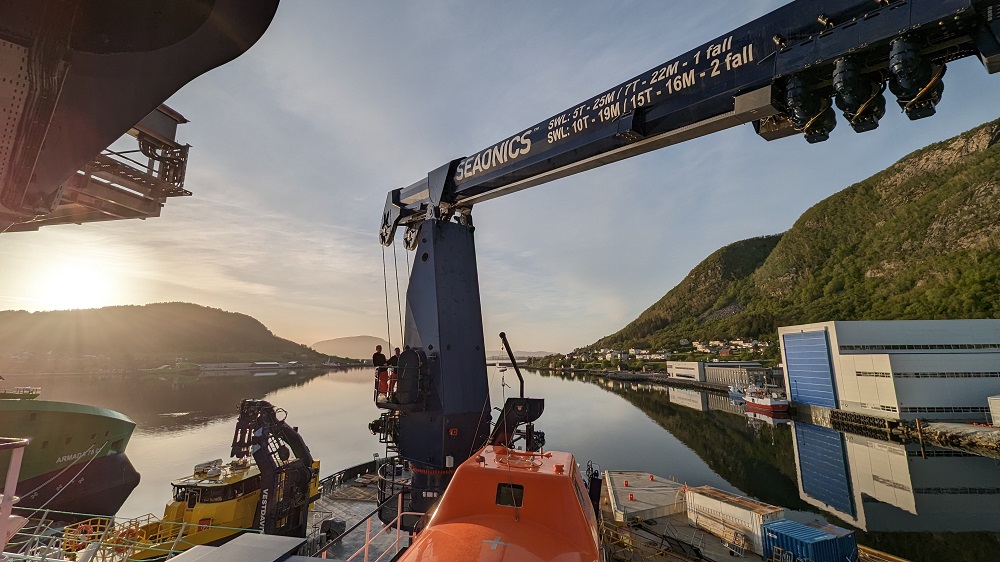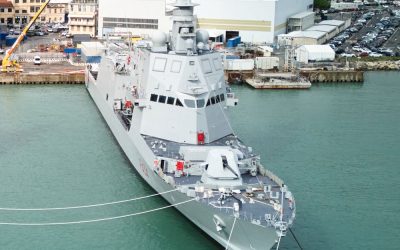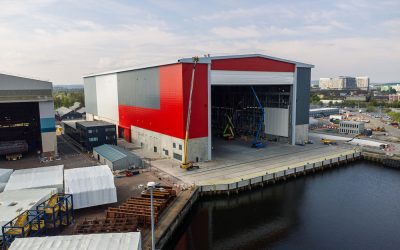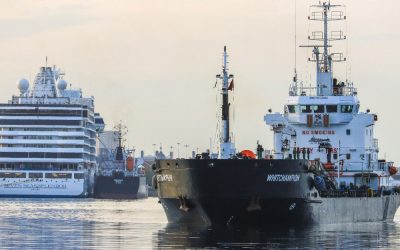Electrification of the offshore sector has been steadily advancing for a number of years now with offshore wind vessels in particular at the forefront of innovation. In June this year, Norwegian owner REM Purus took delivery of the Vard-built 85 metre diesel-electric/battery hybrid CSOV REM Power, the first vessel to be equipped with Kongsberg Rim azimuth propellers as main propulsion.
But arguably the vessel’s most striking innovation is to be found above decks. Developed by Vard subsidiary Seaonics and originally announced last year, the telescopic Electric Controlled Motion Compensated (ECMC) crane is the world’s first fully-electric 3D compensated active heave crane.
Although utilising Seaonics’ active heave compensation (AHC) control system it’s in essence a reimagining of its earlier hydraulic AHC crane, offering greater responsiveness and entirely negating the risk of a polluting oil spill. A complementary ECMC telescopic gangway – utilising Seaonics’ proprietary solution for achieving active motion compensation control of an articulated gangway using signals from a Motion Reference Unit – has also been launched.
Tom Jørann Giske, SEAONICS’ senior systems engineer and product manager for the ECMC crane and gangway, says the crane, which has a capacity of 5 tonnes at 25 metres in 3D compensated mode, has been designed with everyday SOV use in mind.
He explains: “A lot of the operation that’s done in these vessels’ daily life is cargo that’s less than a tonne. We really wanted to make a crane that’s effective in operation on deck and towards the TP [transition piece]. With the way that we do our motion compensation, it’s the tip of the crane and the gangway that stand still during operation, then you rule out a lot of other issues. Other cranes achieve heave compensation with a winch but we didn’t want to go to the market with a cascade of systems working together.”
Stig Espeseth, SEAONICS’ chief technology officer and also founder, adds that when they arrived at the telescopic solution it soon became clear that electric motors were the best means of simplifying the design.
He says: “We wanted to have the strength of the knuckle boom crane, which means getting close to the cargo when picking up, and we achieved this by rearranging the telescope and making new arrangements. It was obvious to us it was a good solution and that was also the comment from our customers when we started presenting this to them.”
Outperforms hydraulic
Given the difficult sea states in which motion compensated equipment is often required to operate it’s critical to have a drive system that’s responsive; even a low-cost electrical solution will outperform the top-shelf hydraulic options, delivering full torque from zero speed.
“By using electric drive solutions, which have closed-loop monitoring, we know from all our experience that it’s reliable and gives us the action we want to have. In an operation it amps up the safety. When the vessel is so close to the structure, if you mess it up then you risk incidents and you really don’t want that,” says Giske.
A significant downside of hydraulic cranes is the lubricating oil, which can be anything up to 10,000 litres for large cranes. Although the oil is contained at pressure, with monitoring to warn of any leakage, it only takes a few seconds to spill a lot of oil. An electric crane has no such requirements and therefore negates the risk of major pollution.
That’s not to say there aren’t some challenges with electric cranes. Giske notes that more space is required to accommodate the various drive units with an electrical system, while Espeseth adds that – as with the early days of developing active heave compensation and gangways – they needed to work closely once again with class society to establish the rules and regulations and matters such as manual and automatic overload protection systems.
But like past innovations, such as feeding surplus power from the crane back into the vessel’s electrical grid, what may once have been greeted with scepticism could eventually become commonplace. What can be said with confidence is that the ECMC crane translates into significant fuel savings; approximately 100-200 tonnes per vessel per year.
So far Seaonics has signed contracts for six ECMC cranes, with the two delivered so far both going to REM Purus. Giske says the latter’s faith in them, as well as that of Vard, has been vital to the project’s success: “Just the fact that they really believed in how we wanted to simplify this operation. Simply looking at the crane it’s not easy to understand how it’s achieving this complexity in an operation that’s moving. With our competitors you would see a lot more equipment but I think that’s our strength.”
Long history
Although founded 12 years ago, Seaonics’ origins actually lie further back, during the formative years of the offshore wind segment in the early 2000’s. In 2004, Danish engineering company Vestas, which was building the seminal Horns Rev wind farm in the North Sea, was contracted by Norwegian shipowner Fredrik Odfjell to supply a small catamaran, FOB Junior, that would be used to not only service the turbines but also, where necessary, to change the blades.
To assist him, Odfjell partnered with a small Ålesund-based company, ICD [Industrial Control Design] Projects AS, which developed the first 3D active heave compensated (AHC) work deck.
Stig Espeseth, who was ICD Projects’ founder and managing director, is credited as one of the masterminds behind the technology and it established ICD as the go-to authority on AHC systems. ICD Projects was acquired by TTS Marine in 2007 and was the foundation for TTS Offhore Handling. In 2011 ICD, jointly founded Seaonics with Norwegian shipbuilder Vard.
“We saw there were openings and changes in the market after 2008 and saw the possibility to take a position as a company with strong foundations in a large yard,” says Espeseth. However, while Seaonics supports Vard to serve as a one-stop-shop for clients, much of its market lies elsewhere and the company operates independently.
The company’s growth has been an organic process. In its early years the company focused heavily on supplying electric winches for fishery vessels, capitalising on the need for extensive fleet renewal programme at the time. Launch and recovery systems for offshore service and construction vessels – in which Vard had a large market share – also proved a fruitful segment. From there it was a short stepping stone into developing other solutions, particularly as a means for extending the working window for vessel operations.
Seaonics prides itself on its design-centred approach to developing its solutions. Espeseth explains: “First we do the investigation where we talk with our customers and get an in-depth understanding of the customer needs, what kinds of operations they need to carry out and what equipment should be used and what conditions.
“Then we go into the definition stage where we define the customer needs and problems and get the visual description with illustrations. After that we have idea generation within the interdisciplinary team, and that is the main purpose for the concept solution team.”
After that comes prototyping, where ideas are transformed into practical solutions, followed by factory-, harbour- and sea-acceptance trials (FAT, HAT and SAT). Although around 90 staff are based at the company’s Norwegian offices, a further 70 work at facilities in Gdansk, Poland, where the company’s electric switchboards and cabinets and control system units are also manufactured.
Espeseth comments: “We have focused on having outsourced the production model. We do the design of the equipment and the production drawings, and a follow-up team for our sub-suppliers, service and aftermarket. We have cooperation partners doing the steel production and the facilities for testing. Since the beginning we have focused a lot on using our simulation toolbox to ensure that the products are working correctly.”
Through its wholly-owned subsidiary CDP Technologies it created CDP Studio, the core platform for its software and control system development, which makes it possible to replicate the kinematics of different systems and then use the feedback from that to make further adjustments. Training simulators incorporate the crane or gangway’s actual control system and then build the physical and virtual environment around that.
By Espeseth and Giske’s own admission, Seaonics’ equipment isn’t always the cheapest, but does represent a competitive solution with future proof solutions built to last the 20-30 years of a vessel’s operational lifetime, which in turn reduces maintenance costs and improves sustainability.
“Yes, it is good to see that the customers that enabled us to develop innovative products a decade ago, is also the ones taking on our new ECMC products now. And it is fun to see that the first systems we delivered sometimes is sold to new customers. It’s important for us to support these [second hand] customers and ensure these systems remain cost effective and profitable for them also,” says Giske.






